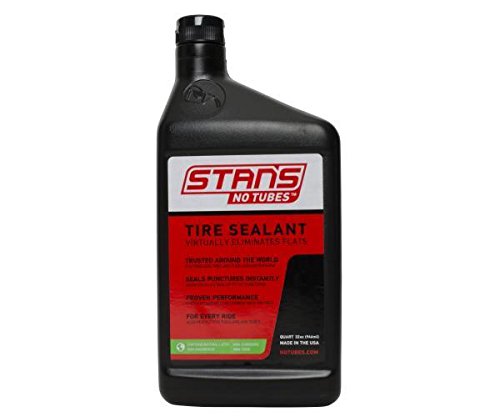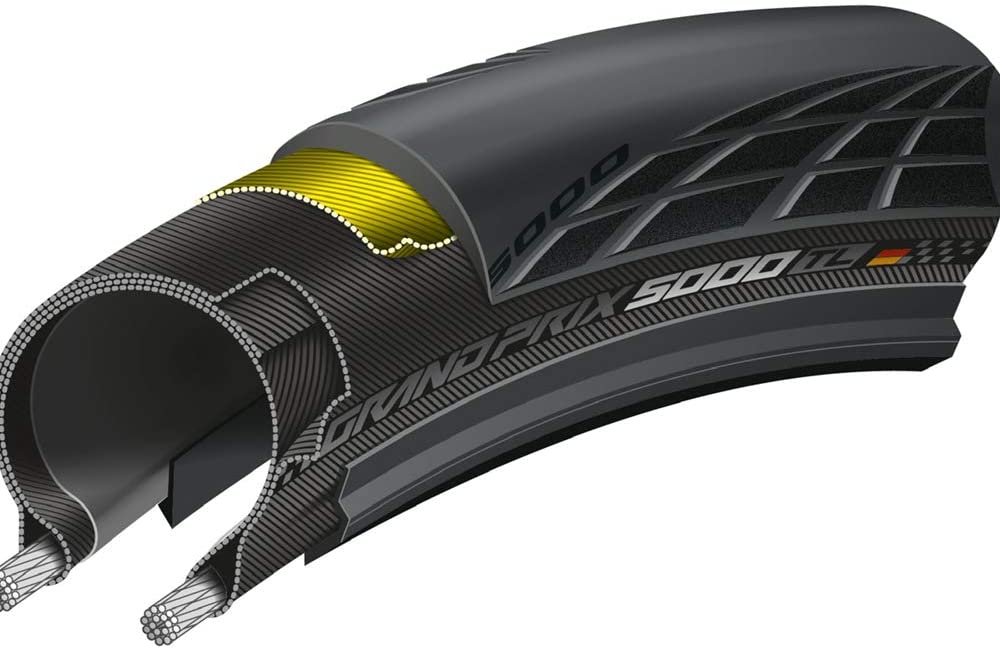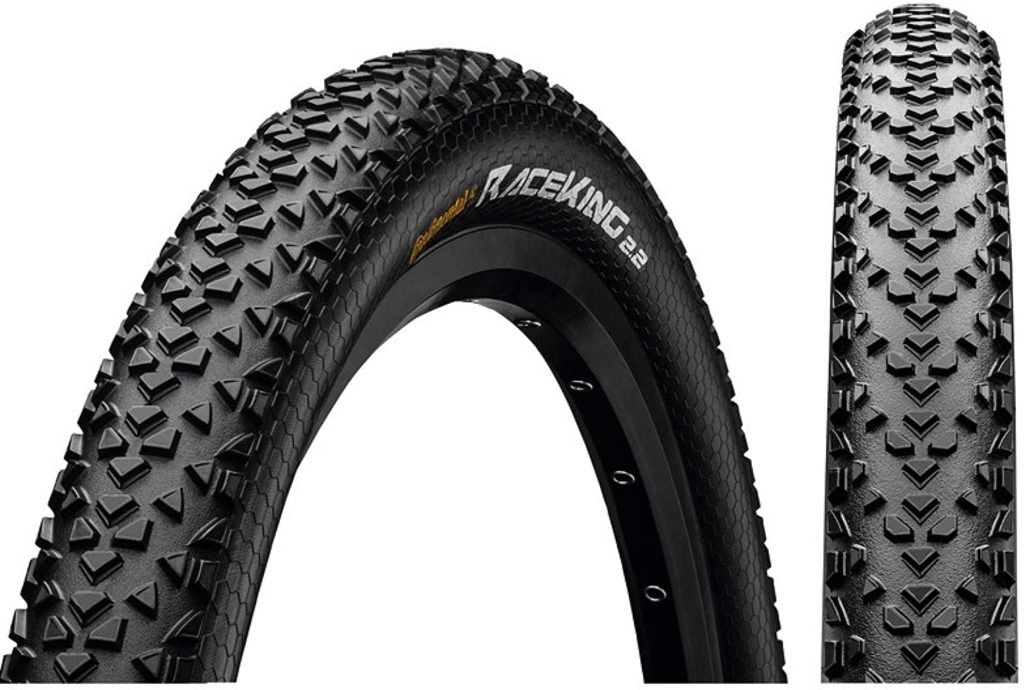In this post, we will hopefully cover everything you need to know about tubeless tires. During our research, we found a number of recurring questions that cyclists kept asking and we found there were no real definitive answers for them.
Hence why in this article you will find full in-depth answers to these common questions and at the end, we have reviewed the best tubeless road tires.
Have a scroll through the table of contents to jump to a question you want the answer to.
Table of Contents
What Are Tubeless Tires?
In order to understand how tubeless tires work, here’s a quick refresher on the three main types of bicycle tires: conventional clincher, tubular, and tubeless clincher.
• Conventional clincher
• Tubular
• Tubeless clincher.
Conventional clinchers are the most common type of tire retailed on bikes. As the innertube inflates, it pushes against the rim and tire beads together, which secures the tire to the rim.
A clincher tire is held on mainly with air pressure, and while they are simple to fit in when you get a flat, they become a bit heavier, and tubes are vulnerable to pinch flats.
Tubulars have an inner tube that is totally enclosed by the tire casing, which is stitched together at the bottom. The tire is glued to the rim.
The advantage to tubulars is a highly developed ride quality and, the lowermost weight, and rolling resistance. The disadvantages are flats (with no simple fix) and complicated installation.
Tubeless tires have the same overall cross-section as a conventional clincher, but then without an inner tube. In its place, it has a layer in the tire casing or liquid sealant which is used to make the tire resistant to air.
The rim and tire beads have a different shape than conventional clinchers, with interlocking outlines that form a seal under pressure.
Are Tubeless Worth it why should you should switch to them?
Yes, they totally are, in short, there have been some urban myths surrounding tubeless tires. In the initial days of tubeless technology, there was a lack of trustworthiness in tubeless systems.
The overall weight of the sealant and tires were big concerns. However, this was over 10 years ago, and the technology has become much more advanced.
The tires are lightweight (which is one of their many advantages), they eliminate the need for patchwork and tubeless mountain bike tires provide better traction. There is a long list of pros but to wrap it up they are worth it and in the future, I think they will overrule the traditional tube tires, because of their puncture resistance
It is important to remember if you don’t ride often, make sure to be mindful of the need to sustain and add small doses of additional sealant.
Overall, just try not to let it dry out by keeping your bike indoors and out of very hot and dry conditions.
Are tubeless Tires more puncture resistant?

A huge benefit of road bike tubeless tires is the small risk of getting punctured tires making them more puncture resistant. There are two primary explanations for this.
Firstly because there is no inner tube the risk of pinch punctures is entirely eliminated.
The second reason is the latex sealant is used to make sure that the tire stays airtight and is sealed to the wheel rim.
The sealant contains miniature rubber particles that plug holes and repair punctures as you are riding.
They are specifically designed to seal holes up to approximately 2 mm wide so for most typical punctures such as a tiny piece of glass, stone, or a thorn the sealant will immediately block the hole sealing the puncture.
Most often than not you won’t even know that you have even had a puncture and it won’t be until you finish cycling and notice a small damp patch on the tire that you grasp the sealant has sealed a hole.
Of course, tubeless tires are not 100% totally puncture resistant and the sealant will struggle to repair bigger tire cuts. But they are most certainly more puncture resistant than traditional road tires
What’s the advantage of tubeless tires?
1. Tubeless mountain bike tires provide better traction
With tubeless Mountain Bike tires, you can have a much smoother ride with the capability to maintain traction in rough terrain.
This is because the aim in biking is to keep the tire on the ground as much as you can. While suspension does most of the work in soaking up the impact and keeping the tires on the ground, tire pressure is the second most significant factor.
In a tubeless MTB system, the aptitude to run a lower tire pressure means that you will have more ground contact and the tire can bend around objects.
With the lower pressure, technical climbing also becomes more fun, primarily because the tread of the tire grasps obstacles and the impact is better absorbed and distributed.
2. Reduce weight from tires
A regular 29er tube weighs about 200 grams. Latex-filled self-sealing tubes (designed to copy tubeless setups) can weigh more than 400 grams each.
In a common tubeless setup, you will be looking at around 125 grams of sealant in each tire, this totals that the overall weight savings can be anywhere from 150 – 650 grams by removing the tube.
Although, the weight savings may seem nominal (maybe 400 grams in total) when you are powering up tough technical sections or trekking through climb after climb, you will defiantly notice the difference
3. Eliminate Pinch Flats
If you go racing with your bike or simply have an intense bike ride you will know all too well when landing a large drop and you think you have made it then the tire folds.
That technical term is a pinch flat, or it’s also known as a snake bite. This happens because of the impact, the tube has pinched amid the rim and the tire, triggering a distinct two-hole large tear in the tube.
With traditional tires, you will likely need an extra tube to fix the issue. If you are a racer, you know those precious minutes spent fixing the issue will be the difference between a podium finish and a potential DNF.
However, with a tubeless setup, pinch flats are much less likely to happen. Large impacts or running too low of tire pressure can definitely lead to “hiccups” where the pressure pushes past the rim and tire walls.
Nevertheless, if the tire hasn’t unseated itself from the rim (quite impossible to do) the issue is simply fixed by adding more air from a pump.
How long do tubeless tires last?
Your tubeless tire can last forever the question should be how long does the sealant on a tubeless tire last? The sealant is what repairs the punctures on your tubeless tire so this is the actual question.
At the very least, you should change the sealant every 6 months or so. If you have a very good tubeless setup then they will stay inflated well beyond that time, as the latex in the sealant has already sealed any small holes.
However it is important to note, the sealant does dry over time, so the system’s ability to self-repair when you run over a thorn or sharp rock is greatly reduced.
Ultimately we recommend checking your tires at the beginning of the riding season, and every few months during the riding season.
Do tubeless tires go flat?
In short yes tubeless tires can go flat if you don’t replace the sealant after it has worn out, if you don’t do this then the tubeless tire won’t be able to repair itself as simple as that. If you do have a flat tire because of this there are ways to fix it. (One is below)
How to Repair a Flat tubeless tire?
To cut down on flats, it is vital to check your sealant regularly (every few months or even more in hot environments).
Just pop the bead and make sure the sealant is still in liquid form. Or you can wiggle the tire from side to side to see if you can hear it slopping around.
If it has dried up, pull the tire, clean out the debris, and reapply fresh sealant.
Tubeless tires require slightly different setup techniques and have higher maintenance requirements than conventional clinchers.
How to install a tubeless tire?
We won’t sugar-coat this and to tell the truth, for the very first time installing a tube can be quite an unsatisfying experience. However, it can be done in just 10mins
Fear not we have some tips to help you on doing this.
First, you use the tube, inflate it to its normal pressure, and then set the wheel out in the warm sun for around an hour or so.
The reason why you do this is that this does three things at once. Those things are it gets the tape stuck down consistently to the rim, it pushes all the air bubbles out of the tape, and then it seats at least one bead of the tire.
Also, if you are using brand new tires, it also helps the tire bead soften the twists that occur from the tire being stored folded for extended periods, which can prevent it from seating.
After this, you take the wheel indoors and let it cool to room temperature (so the rim tape adhesive isn’t slushy).
Then, pop one bead off, remove the tube, install the valve stem and replace the bead. Add the recommended amount of sealant through the stem, replace the valve core, and then finally inflate.
What is the BEST tubeless tire?
Continental Grand Prix 5000 – Best Tubeless Tires

In our opinion, the Continental grand Pix 5000 is the best tubeless tire. Continental made its First tire in 1871.
It’s reasonable to say the German brand has a bit of experience in this field knows a few things when it comes to making tires.
It is no accident that they are the most popular brand in the Pro-Peloton.
The predecessor (GP 4000) came about around 14 years ago and it is renowned for being the best all-around road bike tire available on the planet.
Now with the GP 5000, they have just made it better when it seemed impossible how they can make such a tire even better.
The GP 5000 has got a more clear-cut tread pattern on the new tire, and this is down to Continentals’ molds now being laser cut rather than the machine. This is said to improve the cornering grip.
Durability
The new GP 5000 tubeless tire has a whopping 17% percent lower rolling resistance than the 4000. And this is due to the new re-improved Black Chili compound, and a higher 180 TPI, that’s Threads Per Inch carcass.
This tire has more cushion and comfort as well as working on grip and rolling resistance, the new continental tire design has had its ears open to the ever louder conversation around comfort.
As a result of this for the first time ever, it has embedded what they call ‘Active Comfort Technology’. This sits below the Vectran Breaker, and apparently without affecting rolling resistance, diminishes buzz and vibration.
Another excellent feature of these tires is that they are grippy without being sticky.
The GP500 is an all-season all-rounder. A one of a kind exceptional creation that manages to tick all the boxes and still be masterful enough across puncture resistance, grip, and rolling resistance.
In summary, this is the best tubeless tire for a number of reasons and some pros and cons are below
Pros

It is made of a black chili compound

Provides excellent grip

This has a Vectran breaker
Cons

Expensive when compared to other tubeless tires

Continental Mountain Bike ProTection Tire

We included this tire on our list for a more affordable option without comprising on quality.
The Continental Mountain Bike tubeless tire is an excellent tire and is really underpriced in our opinion. It comes in a range of different styles to suit your needs.
It combines puncture protection and a multipurpose profile design with decent rolling characteristics at a competitive weight for Enduro World Series racing.
Its equally distributed and broadly spaced tread blocks give you the exact amount of bite when necessary.
This design is the result of a total of two years of development between Continental engineers, and the test rider program which includes the Saracen-Madison team, which is quite impressive.
Featuring black chili compound, folding beads, and their new ProTection construction which delivers reduced weight the tire has surprising depth in what it can do.
Pros

It is made of a black chili compound

Provides excellent grip

This has a Vectran breaker
Cons

Expensive when compared to other tubeless tires




